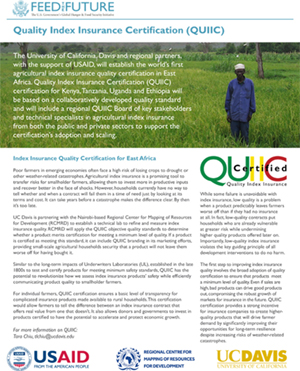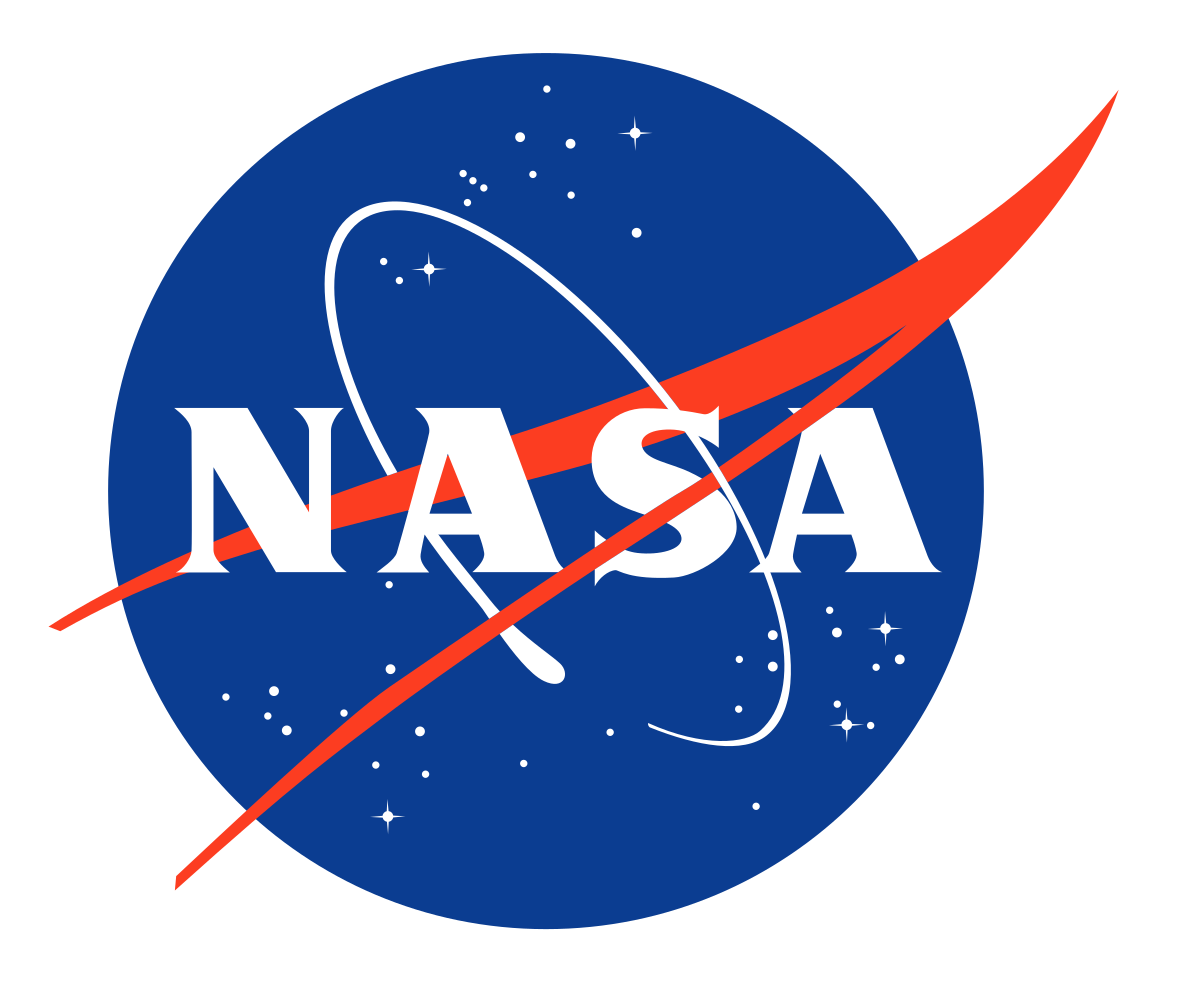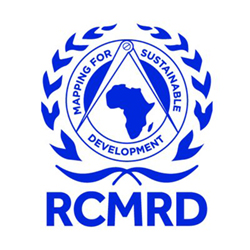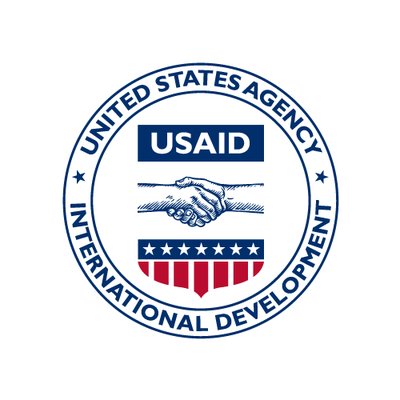The University of California, Davis and regional partners, with the support of USAID, is working to establish the world’s first agricultural index insurance quality certification in East Africa. Quality Index Insurance Certification (QUIIC) certification for Kenya, Tanzania, Uganda and Ethiopia will be based on a collaboratively developed quality standard and will include a regional QUIIC Board of key stakeholders and technical specialists in agricultural index insurance from both the public and private sectors to support the certification’s adoption and scaling.

Poor farmers in emerging economies often face a high risk of losing crops to drought or other weather-related catastrophes. Agricultural index insurance is a promising tool to transfer risks for smallholder farmers, allowing them to invest more in productive inputs and recover better in the face of shocks. However, households currently have no way to tell whether and when a contract will fail them in a time of need just by looking at its terms and cost. It can take years before a catastrophe makes the difference clear. By then it’s too late.
UC Davis is partnering with the Nairobi-based Regional Center for Mapping of Resources for Development (RCMRD) to establish a technical lab to refine and measure index insurance quality. RCMRD will apply the QUIIC objective quality standards to determine whether a product merits certification for meeting a minimum level of quality. If a product is certified as meeting this standard, it can include QUIIC branding in its marketing efforts, providing small-scale agricultural households security that a product will not leave them worse off for having bought it.
Similar to the long-term impacts of Underwriters Laboratories (UL), established in the late 1800s to test and certify products for meeting minimum safety standards, QUIIC has the potential to revolutionize how we assess index insurance products’ safety while efficiently communicating product quality to smallholder farmers. For individual farmers, QUIIC certification ensures a basic level of transparency for complicated insurance products made available to rural households. This certification would allow farmers to tell the difference between an index insurance contract that offers real value from one that doesn’t. It also allows donors and governments to invest in products certified to have the potential to accelerate and protect economic growth.
The QUIIC team is available now to test existing and planned insurance products for eastern and southern Africa. To begin the process of getting a product certified, contact QUIIC project manager Tara Chiu at tlchiu@ucdavis.edu.
QUIIC Partners
 The UC Davis Department of Agricultural and Resource Economics consistently ranks at the top of the agricultural and applied economics profession and are part of the best university in the world for agriculture and forestry. The depth, breadth and rigor of our teaching, research and outreach enable them to make major contributions to society in the areas of agriculture, environment and natural resources, and international development. They offer a popular Managerial Economics undergraduate major and top-rated Ph.D. and Masters programs. Learn more at https://are.ucdavis.edu.
The UC Davis Department of Agricultural and Resource Economics consistently ranks at the top of the agricultural and applied economics profession and are part of the best university in the world for agriculture and forestry. The depth, breadth and rigor of our teaching, research and outreach enable them to make major contributions to society in the areas of agriculture, environment and natural resources, and international development. They offer a popular Managerial Economics undergraduate major and top-rated Ph.D. and Masters programs. Learn more at https://are.ucdavis.edu.
 Researchers at the Ecology, Geography, and Agriculture lab at UC Davis use quantitative methods to study crop ecology, agricultural biodiversity, and agricultural development and their effects on health, wealth, and the environment. The laboratory is under Professor Robert Hijmans’ in the Department of Environmental Science and Policy, which is helping to improve environmental policies, protect biodiversity, understand ecological processes, and foster an interdisciplinary perspective on environmental and natural resource issues. Learn more at https://biogeo.ucdavis.edu/.
Researchers at the Ecology, Geography, and Agriculture lab at UC Davis use quantitative methods to study crop ecology, agricultural biodiversity, and agricultural development and their effects on health, wealth, and the environment. The laboratory is under Professor Robert Hijmans’ in the Department of Environmental Science and Policy, which is helping to improve environmental policies, protect biodiversity, understand ecological processes, and foster an interdisciplinary perspective on environmental and natural resource issues. Learn more at https://biogeo.ucdavis.edu/.
 SERVIR, a joint venture between NASA and the U.S. Agency for International Development (USAID) in Washington, provides state-of-the-art, satellite-based Earth monitoring, imaging and mapping data, geospatial information, predictive models and science applications to help improve environmental decision-making among developing nations in eastern and southern Africa, the Hindu-Kush region of the Himalayas and the lower Mekong River Basin in Southeast Asia. NASA and USAID opened the SERVIR-Eastern and Southern Africa hub at RCMRD in 2008. Learn more at https://www.nasa.gov/mission_pages/servir.
SERVIR, a joint venture between NASA and the U.S. Agency for International Development (USAID) in Washington, provides state-of-the-art, satellite-based Earth monitoring, imaging and mapping data, geospatial information, predictive models and science applications to help improve environmental decision-making among developing nations in eastern and southern Africa, the Hindu-Kush region of the Himalayas and the lower Mekong River Basin in Southeast Asia. NASA and USAID opened the SERVIR-Eastern and Southern Africa hub at RCMRD in 2008. Learn more at https://www.nasa.gov/mission_pages/servir.
 The Regional Centre for Mapping of Resources for Development (RCMRD) was established in 1975 under the auspices of the United Nations Economic Commission for Africa (UNECA) and the African Union (AU). It is an inter-governmental organization and currently has contracting Member States in the Eastern and Southern Africa Regions. The SERVIR hub at RCMRD serves all of eastern and southern Africa, which faces regular, often disastrous flooding conditions -- interspersed with periods of extreme drought -- with far-reaching economic and public health ramifications. Learn more at https://www.rcmrd.org.
The Regional Centre for Mapping of Resources for Development (RCMRD) was established in 1975 under the auspices of the United Nations Economic Commission for Africa (UNECA) and the African Union (AU). It is an inter-governmental organization and currently has contracting Member States in the Eastern and Southern Africa Regions. The SERVIR hub at RCMRD serves all of eastern and southern Africa, which faces regular, often disastrous flooding conditions -- interspersed with periods of extreme drought -- with far-reaching economic and public health ramifications. Learn more at https://www.rcmrd.org.
 USAID leads international development and humanitarian efforts to save lives, reduce poverty, strengthen democratic governance and help people progress beyond assistance. USAID’s work advances U.S. national security and economic prosperity, demonstrates American generosity, and promotes a path to recipient self-reliance and resilience. Learn more at https://www.usaid.gov.
USAID leads international development and humanitarian efforts to save lives, reduce poverty, strengthen democratic governance and help people progress beyond assistance. USAID’s work advances U.S. national security and economic prosperity, demonstrates American generosity, and promotes a path to recipient self-reliance and resilience. Learn more at https://www.usaid.gov.
